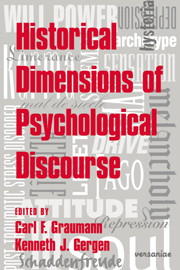Book contents
- Frontmatter
- Contents
- List of contributors
- 1 Psychological discourse in historical context: An introduction
- Part I Disciplining psychological discourse
- 2 The practice of psychological discourse
- 3 From tools to theories: Discovery in cognitive psychology
- 4 Metaphor and monophony in the twentieth-century psychology of emotions
- 5 Psyche and her descendants
- Part II History as culture critique
- Part III Early antecedents
- Part IV Lived history
- Author index
- Subject index
4 - Metaphor and monophony in the twentieth-century psychology of emotions
Published online by Cambridge University Press: 20 October 2009
- Frontmatter
- Contents
- List of contributors
- 1 Psychological discourse in historical context: An introduction
- Part I Disciplining psychological discourse
- 2 The practice of psychological discourse
- 3 From tools to theories: Discovery in cognitive psychology
- 4 Metaphor and monophony in the twentieth-century psychology of emotions
- 5 Psyche and her descendants
- Part II History as culture critique
- Part III Early antecedents
- Part IV Lived history
- Author index
- Subject index
Summary
Attempts to define the emotions and elucidate their character have ornamented the intellectual landscape for over two thousand years. Two characteristics of this continuing colloquy are particularly noteworthy: first, the presumption of palpability and, second, the interminability of debate. In the former case, until the present century there has been little doubting the obdurate existence of the emotions. In the second book of the Rhetoric, Aristotle distinguished among 15 emotional states; Aquinas's Summa Theologiae enumerated 6 “affective” and 5 “spirited” emotions; Descartes distinguished among 6 primary passions of the soul; the eighteenth-century moralist, David Hartley, located 10 “general passions of human nature”; and the major contributions by recent theorists, Tomkins (1962) and Izard (1977), describe some 10 distinctive emotional states. In effect, the cultural history is one in which there is unflinching agreement regarding the palpable presence of emotional states within persons.
At the same time, these deep ontological commitments are also matched by a virtual cacophony of competing views on the character of the emotions – their distinguishing characteristics, origins, manifestations, and significance in human affairs. For Aristotle the emotions constituted “motions of the soul”; for Aquinas the emotions were experienced by the soul, but were the products of sensory appetites; Descartes isolated specific “passions of the soul,” these owing to movements of the “animal spirits” agitating the brain.
- Type
- Chapter
- Information
- Historical Dimensions of Psychological Discourse , pp. 60 - 82Publisher: Cambridge University PressPrint publication year: 1996
- 2
- Cited by



